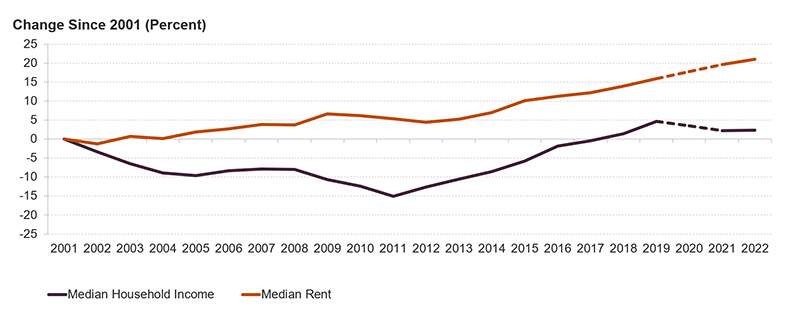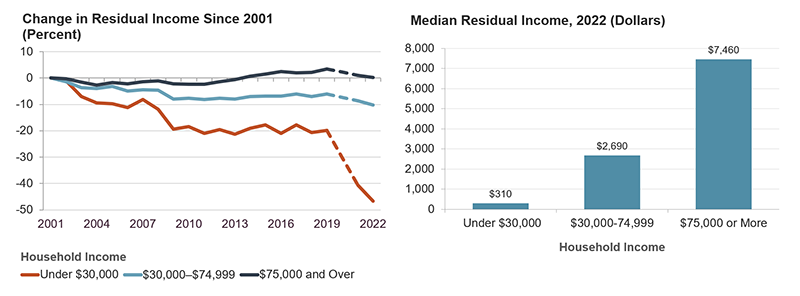High Housing Costs Are Consuming Household Incomes
Our latest America’s Rental Housing report points to an escalating affordability crisis. In the years since the COVID-19 pandemic, the rapid increase in rents combined with widespread financial hardship have pushed the number of cost-burdened renters to a record high of 22.4 million households in 2022. As housing costs have outpaced income gains by a widening margin, lower-income renters have less left over after paying for housing than ever before. In 2022, the median residual income remaining after rent payment fell to a record low of just $310 each month for lower-income renters, far below the minimum needed to afford an adequate standard of living.
In recent decades, rents have dramatically outpaced renter household incomes (Figure 1). Between 2001 and 2022, the median rent increased by 21 percent, while the median renter household income increased by just 2 percent, after adjusting for inflation. Rents have grown rapidly across all income groups. Since 2001, the median rent for households earning $75,000 or more increased by 27 percent, to $1,800 in 2022. This was the largest increase of any income group. Still, the median rent for middle-income households earning between $30,000 and $74,999 increased by a sizeable 18 percent (to $1,300), while the median rent for households earning less than $30,000 grew by 14 percent (to $940). Although lower-income households experienced the smallest increase in median rents, this is a group for whom housing is persistently unaffordable; in 2022, 83 percent of renter households earning less than $30,000 were cost burdened.
Figure 1: Rent Growth Has Outpaced Income Gains for Renters
While rents have risen across the board, income trends have diverged. Households earning $75,000 or more saw a 3 percent increase in median incomes between 2001 and 2022, while middle- and lower-income renter households saw reductions in their real earning power. The median income for renter households earning between $30,000 and $74,999 fell by 2 percent in this period, while the median income for households with incomes below $30,000 fell by 12 percent. For lower-income renters, this reduction in real income accelerated since the pandemic, as unemployment climbed and many lower-income workers lost wages due to economic disruptions.
Figure 2: Lower-Income Renters’ Residual Incomes Have Plummeted Since the Pandemic
Caught between rising rents and falling incomes, lower-income renters’ residual income has plummeted to record lows (Figure 2). From 2001 to 2022, the median residual income for all renter households declined by 4 percent. Among households making less than $30,000, the median residual income fell by a staggering 47 percent, leaving the median lower-income renter household with just $310 each month to cover all non-housing expenses. The pandemic accelerated the long-term decline in residual incomes. Between 2019 and 2022 alone, the median residual income for lower-income renters fell by $160, a greater decline in three years than the entire amount lost between 2001 and 2019 ($110).
Middle-income households also saw reductions in their residual incomes. In 2022, households earning between $30,000 and $74,999 had a median residual income of $2,690, down 4 percent since the pandemic, and 10 percent since 2001. In contrast, higher-income renters were relatively insulated; households earning $75,000 or more had a median residual income of $7,460 in 2022, an increase of less than half a percentage point from 2001.
Low residual incomes leave households without enough to cover essential expenses such as food, healthcare, transportation, and childcare. Our tabulations of data from the Economic Policy Institute’s Family Budget Calculator indicate that even in the most affordable counties in the United States, a one-adult household still would need a minimum of $2,000 per month to afford all non-housing expenses and maintain a modest yet adequate standard of living in 2022. A household with two adults would need a minimum of $2,800 in the most affordable counties, and a household with one adult and one child would need a minimum of $2,900.
With so little left over, financially vulnerable renters often have no choice but to reduce spending on areas critical to their well-being. Our tabulations of the 2022 Consumer Expenditure Survey indicate that severely cost-burdened renter households in the lowest expenditure quartile – a proxy for low incomes – spent 39 percent less on food and 42 percent less on healthcare than households in their expenditure group who were not cost burdened. Housing unaffordability often compels households with limited means to make other sacrifices, such as relocating to a different neighborhood or living in overcrowded or physically inadequate conditions, which come with lower rents but can harm their health and well-being. Even when they are not cost burdened, lower-income renters do not have enough left over to cover their essential non-housing expenses.
As housing costs have outpaced incomes in recent decades, rental subsidies have not kept up with need. In 2021, only one in four income-eligible households received housing assistance, leaving 14.2 million eligible renter households unassisted. With many renters living on thinner financial margins than ever, a greater investment in subsidies will be necessary to protect financially vulnerable renters and mitigate the painful tradeoffs that are increasingly a fact of life for many households.



